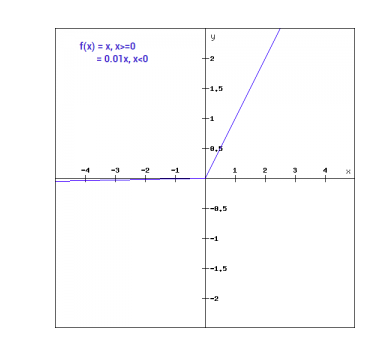Relu ou Função de Ativação Linear Retificada é a escolha mais comum de função de ativação no mundo do aprendizado profundo. Relu fornece resultados de última geração e é computacionalmente muito eficiente ao mesmo tempo.
O conceito básico da função de ativação Relu é o seguinte:
Return 0 if the input is negative otherwise return the input as it is.
Podemos representá-lo matematicamente da seguinte forma:

O pseudocódigo para Relu é o seguinte:
if input > 0:
return input
else:
return 0
Neste tutorial, aprenderemos como implementar nossa própria função ReLu, entenderemos algumas de suas desvantagens e conheceremos uma versão aprimorada do ReLu.
Leitura recomendada: Álgebra Linear para Aprendizado de Máquina [Parte 1/2]
Vamos começar!
Implementando a função ReLu em Python
Vamos escrever nossa própria implementação do Relu em Python. Usaremos a função max incorporada para implementá-lo.
O código para o ReLu é o seguinte:
def relu(x):
return max(0.0, x)
Para testar a função, vamos executá-la em algumas entradas.
x = 1.0
print('Applying Relu on (%.1f) gives %.1f' % (x, relu(x)))
x = -10.0
print('Applying Relu on (%.1f) gives %.1f' % (x, relu(x)))
x = 0.0
print('Applying Relu on (%.1f) gives %.1f' % (x, relu(x)))
x = 15.0
print('Applying Relu on (%.1f) gives %.1f' % (x, relu(x)))
x = -20.0
print('Applying Relu on (%.1f) gives %.1f' % (x, relu(x)))
Código Completo
O código completo é fornecido abaixo:
def relu(x):
return max(0.0, x)
x = 1.0
print('Applying Relu on (%.1f) gives %.1f' % (x, relu(x)))
x = -10.0
print('Applying Relu on (%.1f) gives %.1f' % (x, relu(x)))
x = 0.0
print('Applying Relu on (%.1f) gives %.1f' % (x, relu(x)))
x = 15.0
print('Applying Relu on (%.1f) gives %.1f' % (x, relu(x)))
x = -20.0
print('Applying Relu on (%.1f) gives %.1f' % (x, relu(x)))
Saída:
Applying Relu on (1.0) gives 1.0
Applying Relu on (-10.0) gives 0.0
Applying Relu on (0.0) gives 0.0
Applying Relu on (15.0) gives 15.0
Applying Relu on (-20.0) gives 0.0
Gradiente da função ReLu
Vamos ver qual seria o gradiente (derivada) da função ReLu. Ao diferenciar, obteremos a seguinte função:
f'(x) = 1, x>=0
= 0, x<0
Podemos ver que para valores de x menores que zero, o gradiente é 0. Isso significa que os pesos e viés para alguns neurônios não são atualizados. Isso pode ser um problema no processo de treinamento.
Para superar esse problema, temos a função Leaky ReLu. Vamos aprender sobre isso a seguir.
Função Leaky ReLu
A função Leaky ReLu é uma improvisação da função ReLu regular. Para resolver o problema do gradiente zero para valores negativos, Leaky ReLu atribui um componente linear extremamente pequeno de x para entradas negativas.
Matematicamente, podemos expressar Leaky ReLu como:
f(x)= 0.01x, x<0
= x, x>=0
Matematicamente:
- f(x)=1 (x<0)
- (αx)+1 (x>=0)(x)
Aqui é uma pequena constante como o 0,01 que tomamos acima.
Graficamente, pode ser mostrado como:

O gradiente do Leaky ReLu
Vamos calcular o gradiente para a função Leaky ReLu. O gradiente pode ser:
f'(x) = 1, x>=0
= 0.01, x<0
Neste caso, o gradiente para entradas negativas é não-zero. Isso significa que todos os neurônios serão atualizados.
Implementando Leaky ReLu em Python
A implementação para Leaky ReLu é dada abaixo:
def relu(x):
if x>0 :
return x
else :
return 0.01*x
Vamos testá-lo em entradas onsite.
x = 1.0
print('Applying Leaky Relu on (%.1f) gives %.1f' % (x, leaky_relu(x)))
x = -10.0
print('Applying Leaky Relu on (%.1f) gives %.1f' % (x, leaky_relu(x)))
x = 0.0
print('Applying Leaky Relu on (%.1f) gives %.1f' % (x, leaky_relu(x)))
x = 15.0
print('Applying Leaky Relu on (%.1f) gives %.1f' % (x, leaky_relu(x)))
x = -20.0
print('Applying Leaky Relu on (%.1f) gives %.1f' % (x, leaky_relu(x)))
Código Completo
O código completo para Leaky ReLu é dado abaixo:
def leaky_relu(x):
if x>0 :
return x
else :
return 0.01*x
x = 1.0
print('Applying Leaky Relu on (%.1f) gives %.1f' % (x, leaky_relu(x)))
x = -10.0
print('Applying Leaky Relu on (%.1f) gives %.1f' % (x, leaky_relu(x)))
x = 0.0
print('Applying Leaky Relu on (%.1f) gives %.1f' % (x, leaky_relu(x)))
x = 15.0
print('Applying Leaky Relu on (%.1f) gives %.1f' % (x, leaky_relu(x)))
x = -20.0
print('Applying Leaky Relu on (%.1f) gives %.1f' % (x, leaky_relu(x)))
Saída:
Applying Leaky Relu on (1.0) gives 1.0
Applying Leaky Relu on (-10.0) gives -0.1
Applying Leaky Relu on (0.0) gives 0.0
Applying Leaky Relu on (15.0) gives 15.0
Applying Leaky Relu on (-20.0) gives -0.2
Conclusão
Este tutorial foi sobre a função ReLu em Python. Também vimos uma versão aprimorada da função ReLu. O Leaky ReLu resolve o problema dos gradientes zero para valores negativos na função ReLu.
Source:
https://www.digitalocean.com/community/tutorials/relu-function-in-python













